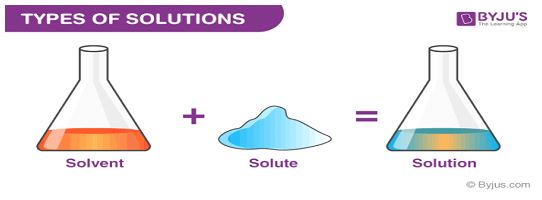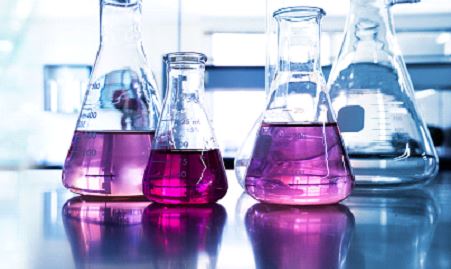Let us learns about the solution, its composition, and various types!
What is a Solution?
A solution is defined as a homogenous mixture of two or more substances. A homogenous mixture means that the substances are evenly distributed in the solution forming a uniform composition. In our everyday life, we come across many solutions like saline solution (salt in water), sugar syrup, perfumes, etc.
Components of a Solution
There are two main components of a solution, a solute, and a solvent.
⦁ Solute: It is a substance that is dissolved in another substance called solvent to form a solution.
⦁ Solvent: The substance in which the solute is dissolved to produce a solution is called a solvent.
Therefore, a solution can also be defined as a homogenous mixture of one or more solutes in a particular solvent. Generally, a solvent is present in a larger quantity while solute is present in a lesser amount in a solution. Both solute and solvent can occur in any of the three states of matter i.e. solid, liquid, or gas.


General Characteristics of a solution
⦁ It is a homogenous mixture of substances.
⦁ A solution can not pass or scatter a beam of light.
⦁ A solution is always present in a stable single phase
⦁ Once formed, solute particles can not be separated from the solution using filtration.
⦁ Particles of the solute can not be seen with a naked eye once a homogenous solution is formed.
Types of Solutions
Solutions can be classified into nine different types based on the physical state of matter of solute and solvent as follows:
- Solid-solid: Both solute and solvent are in the solid phase. Alloys are the most common examples of solid-solid solutions. Brass is an alloy of copper and zinc.
- Solid-liquid: The solute is solid, while the solvent is liquid. The most common example of this type is a solution of sugar or salt in water.
- Solid-gas: Solution of solid solute in a gas solvent. It is quite rare but an example of it is the sublimation of iodine in the air.
- Liquid-solid: A liquid solute is dissolved in a solid solvent. For example, hydrated salts (inorganic salts containing water molecules).
- Liquid-liquid: A common type of solution containing liquid solute and solvent. For example alcohol in water.
- Liquid-gas: A solution of the liquid solute in a gas solvent. Water vapors in the air are a common example.
- Gas-solid: Gas is a solute, while solid acts as a solvent. For example, the absorption of hydrogen in palladium.
- Gas-liquid: Gas is dissolved in a liquid solvent. An example of this type of solution is aerated drinks or carbonated drinks containing dissolved carbon dioxide.
- Gas-gas: Both solute and solvent is a gas. Air is the most common example as it is a mixture of various gases.
Check out other cool chemistry concepts with other chemistry kits below!

